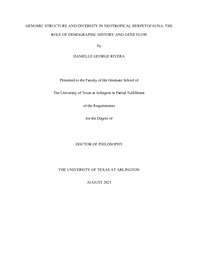
ATTENTION: The works hosted here are being migrated to a new repository that will consolidate resources, improve discoverability, and better show UTA's research impact on the global community. We will update authors as the migration progresses. Please see MavMatrix for more information.
Show simple item record
| dc.contributor.advisor | Fujita, Matthew K | |
| dc.creator | Rivera, Danielle George | |
| dc.date.accessioned | 2022-08-24T17:31:45Z | |
| dc.date.available | 2022-08-24T17:31:45Z | |
| dc.date.created | 2021-08 | |
| dc.date.issued | 2021-08-03 | |
| dc.date.submitted | August 2021 | |
| dc.identifier.uri | http://hdl.handle.net/10106/30901 | |
| dc.description.abstract | The effects of genetic introgression on species boundaries and how they affect species’ integrity and persistence over evolutionary time have received increased attention. The increasing availability of genomic data has revealed contrasting patterns of gene flow across genomic regions, which impose challenges to inferences of evolutionary relationships and of patterns of genetic admixture across lineages. By characterizing patterns of variation across thousands of genomic loci in a widespread complex of true toads (Rhinella), we assess the true extent of genetic introgression across species thought to hybridize to extreme degrees based on natural history observations and multi-locus analyses. Comprehensive geographic sampling of five large-ranged Neotropical taxa revealed multiple distinct evolutionary lineages that span large geographic areas and, at times, distinct biomes. The inferred major clades and genetic clusters largely correspond to currently recognized taxa within Rhinella; however, we also found evidence of cryptic diversity within taxa. Phylogenetic analyses revealed extensive mito-nuclear discordance, while genetic clustering analyses uncovered several admixed individuals within major genetic groups. Accordingly, historical demographic analyses supported that the evolutionary history of these toads involved cross-taxon gene flow both at ancient and recent times. Lastly, ABBA-BABA tests revealed widespread allele sharing across species boundaries, a pattern that can be confidently attributed to genetic introgression as opposed to incomplete lineage sorting. These results confirm previous assertions that the evolutionary history of Rhinella was characterized by various levels of hybridization even across environmentally heterogeneous regions, posing exciting questions about what factors prevent complete fusion of diverging yet highly interdependent evolutionary lineages. | |
| dc.format.mimetype | application/pdf | |
| dc.language.iso | en_US | |
| dc.subject | Phylogenomics | |
| dc.subject | Phylogeography | |
| dc.subject | Gene flow | |
| dc.subject | Introgression | |
| dc.subject | Demographic modeling | |
| dc.title | GENOMIC STRUCTURE AND DIVERSITY IN NEOTROPICAL HERPETOFAUNA: THE ROLE OF DEMOGRAPHIC HISTORY AND GENE FLOW | |
| dc.type | Thesis | |
| dc.degree.department | Biology | |
| dc.degree.name | Doctor of Philosophy in Quantitative Biology | |
| dc.date.updated | 2022-08-24T17:31:45Z | |
| thesis.degree.department | Biology | |
| thesis.degree.grantor | The University of Texas at Arlington | |
| thesis.degree.level | Doctoral | |
| thesis.degree.name | Doctor of Philosophy in Quantitative Biology | |
| dc.type.material | text | |
| dc.creator.orcid | 0000-0002-9100-9945 | |
Files in this item
- Name:
- RIVERA-DISSERTATION-2021.pdf
- Size:
- 35.50Mb
- Format:
- PDF
This item appears in the following Collection(s)
Show simple item record


